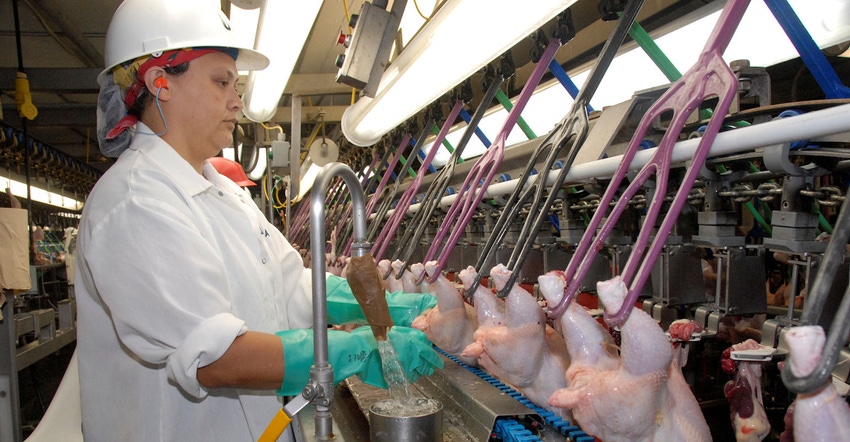Waiver requests would permit young chicken establishments to test new equipment, technologies or procedures at faster line speeds.

As recently stated in the denial of the National Chicken Council’s (NCC) petition requesting a waiver of maximum line speeds for certain poultry slaughter establishments operating under the New Poultry Inspection System (NPIS), the Food Safety & Inspection Service (FSIS) is making available criteria it will use to consider waiver requests from NPIS young chicken establishments to permit these establishments to test new equipment, technologies or procedures that will allow them to maintain process control at faster line speeds.
These waivers will be in addition to line speed waivers granted to the 20 former HACCP-Based Inspection Models Project (HIMP) young establishments after they converted to NPIS. FSIS intends to use the data collected from the additional young chicken establishments that are granted waivers to evaluate their ability to maintain process control when operating at line speeds up to 175 birds per minute (bpm).
NCC spokesman Tom Super said NCC is still reviewing the specific details of the criteria. “We will be working with both our members and the agency to answer questions and determine if the criteria are feasible,” he said.
FSIS said it intends to limit the additional line speed waivers to establishments that have the ability and intent to operate at line speeds faster than 140 bpm.
To be eligible for a line speed waiver, a young chicken slaughter establishment:
Must have been operating under NPIS for at least one year, during which time it has been in compliance with all NPIS requirements;
Must be in salmonella performance standard category 1 or 2 for young chicken carcasses;
Must have a demonstrated history of regulatory compliance -- more specifically, has not received a public health alert for the last 120 days, has not had an enforcement action as a result of a food safety assessment conducted in the last 120 days and has not been the subject of a public health related enforcement action in the last 120 days, and
Must be able to demonstrate that the new equipment, technologies or procedures that allow the establishment to operate at faster line speeds will maintain or improve food safety.
The waiver request submission will need to include documentation that:
Provides details about the establishment’s hazard analysis and critical control point (HACCP) system, including how the establishment addresses the inhibition and reduction of salmonella;
Demonstrates that the establishment has effective process control by submitting one year of microbial data, methodology for evaluating that microbial data (e.g., upper and lower control limits), correlation of that microbial data to the establishment’s sanitary dressing process control data, correlation of that microbial data to FSIS’s salmonella data and interventions to address seasonality;
Describes how existing or new equipment, technologies or procedures will allow for the operation at a faster line speed (e.g., descriptions or names of the equipment, line configuration and verification activities that will be used);
Provides support on how the increased line speed will not negatively affect FSIS employee safety or interfere with inspection procedures (e.g., information about safety protocols or line configuration);
Supports how modifications to its food safety system to operate at the faster line speed will maintain or improve food safety (e.g., a statement that explains how the new equipment will provide the same as or cleaner evisceration processes or how an improved line configuration will continue to prevent cross-contamination), and
Indicates the type of records that will be maintained in the new process, including the collection of information that will assist FSIS in performing appropriate rule-making analysis (e.g., laboratory results, weekly or monthly summary production reports and/or evaluations from inspection program personnel).
FSIS intends to limit waivers for NPIS young chicken establishments to operate at line speeds of up to 175 bpm to those that meet the criteria listed above. Once an establishment is granted a waiver, the Risk Innovations & Management Staff will provide the establishment with the required conditions for operating under the waiver. One condition will be that establishments notify the FSIS inspector-in-charge when they are operating at line speeds higher than 140 bpm to allow FSIS to evaluate the establishment’s ability to maintain process control at a given line speed. Additionally, establishments will need to participate in the Salmonella Initiative Program. Establishments consistently unable to maintain process control at line speeds higher than 140 bpm or consistently operating at line speeds lower than 140 bpm will be subject to waiver revocation.
About the Author(s)
You May Also Like




.png?width=300&auto=webp&quality=80&disable=upscale)
